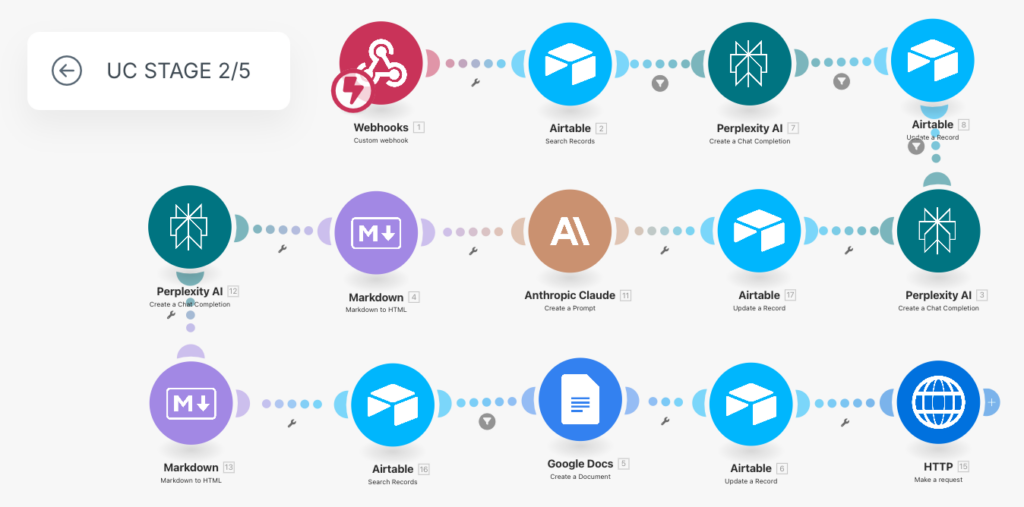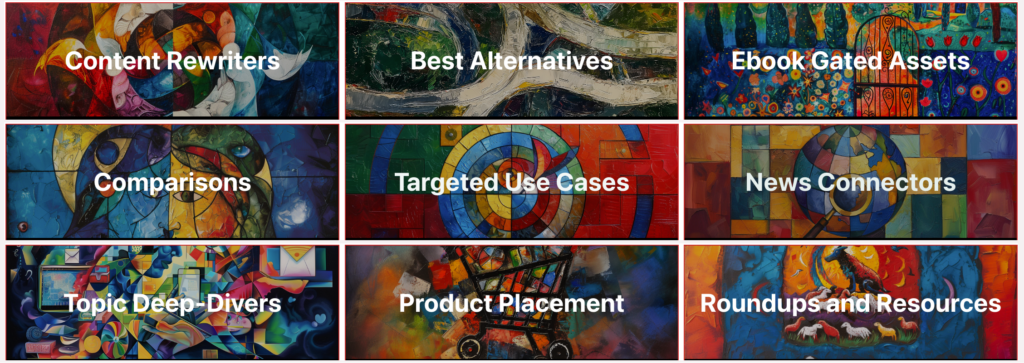Multi-stage, multi-LLM automations for at-scale content marketing:
• In your brand voice, with your SEO strategy
• Based on online research, not old LLM training data
• Hallucination-free, auditable, iterable, private and proprietary
“Agents” are defined differently in different AI circles, but they all have some degree of autonomy. Content agents have the autonomy to work through traditional stages of content production, making at-scale content to the specs you set for each stage and each piece. Content agents are defined as:
Multi-stage automations that use familiar stages of content production—brainstorm, SEO and research, outline, draft, edit, compare, fact check, title and metadata, publishing, promoting, reviewing and updating—with each stage using the best LLM for its goal, and each LLM request including stage-specific context and criteria, to make one piece of content, leaving only the few lowest lift but critical decisions to the human editor.
By automating multiple stages and LLM requests, and orchestrating the prompts and examples for each request, content agents open the doors to new types of content, new scales of content production, and new competitive advantages in organic search.
Why not just use ChatGPT, Claude, LLMs directly?

The more you ask of an LLM, the more it will disappoint.
But the opposite is also true.
These two truths make content agents work. With far narrower requests, content agents use LLMs to the limits of their abilities and not beyond.
When requests are narrower in scope, and have sufficient context and examples, then fully automated, then LLMs become highly effective tools for content production.
So why not break LLM requests into outlines you can edit, and have the LLM write to the outline?
That’s better, but it’s still asking too much. It’s like having a spring and one gear and trying to make a clock. You need lots of gears.
The outline-first approach is the backbone of many SaaS content generation tools and while better than zero- or few-shot content, it’s still too brittle at scale. Outline-first LLM content generation writes with a flow of logic that meanders and half repeats. Editing this content is frustrating and slow.
How do Content Agents compare to online AI content generation tools?

Agents are programmed to follow your content type’s workflow, following it like a brief, and building up to the content Content agents are better than SaaS AI content tools in all the important ways:
Unique, Fully Customized Content: Online content tools make content for ALL companies; content agents make content only for you.
Online AI content tools try to make content that helps all companies, within drop-down parameters. SaaS AI content tools offer minimal customization; they produce content that’s stylistically and rhetorically the same as for other subscribers that checked the same boxes. Without significant editing, this is an ineffective way to compete in the search engines. And, given the SEO penalties for duplicate content, it’s risky as well.
Content agents make content specifically for you, with your SEO strategy and your brand voice and formats. They unlock the (manually impossible) use of large context windows of top LLMs, and when combined in multi-LLM stages makes unique, creative content within your guidelines.
Efficient, Fully Integrated Workflows: Content agents are like coworkers: They use your IT platforms and follow your content workflows.
Editors don’t need to visit third-party websites to create content. Instead, the content is created in the background (via automated API calls and HTTP requests) and shows up where the editor expects it, whether that’s Slack, email, Google Docs or any channel or CMS the content department is already using. Editor-first integration saves dozens of copy-paste-platform-switching steps per piece.
Private, Proprietary and Highly Iterable: Your team owns and can iterate on your content agents, and your internal data can stay that way. Content agents can work with local LLM indexing, or local RAG agents.
After initial setup, content agents become proprietary tools owned by your company. Your team can easily iterate your content agents, and your company can develop new products based on new agent workflows. Online tools cannot be iterated. SaaS AI content tools have drop-downs but behind the scenes are static; they can’t be used to create original content products or develop new company IP. And there’s always the risk that online tools will share your data or use it to train their models.
Content agents do take more time to design and set up. But this design and setup phase only happens once. Once finished, editors have intuitive and direct editorial controls to improve, iterate and spinoff new ideas for new Agents.
How do agents make content with better style, flow and logic?

When LLMs are given too little context and too few examples, they rely on training data to fill in the blanks. This “filling in the blanks” happens on several levels and results in three familiar LLM content problems:
| Content Problem | Scope of Problem | Cause of Problem | Solution |
| Bad voice and style | Word choice and sentence structure | LLM relied on training data for voice and style | Rely on agent to provide style and voice examples with each prompt |
| Unclear flow or logic | Conclusions of paragraphs and entire piece | LLM relied on statistics to shape how paragraphs and the whole piece build to conclusions | Program logic and flow into agent as defined stages, with final stage judge of flow |
| Hallucinations and wrong facts | People, facts, figures | Facts, and how facts relate to other facts | Collect facts during a research stage, then restrict composition stages to provided facts. See below |
Why don’t Content Agents hallucinate? How do they make up-to-date content?

To avoid hallucinations and old facts or figures, content agents never let the (LLM API calls of) composing stages fill in any factual blanks.
Instead, agents begin with a research stage. Later stages reference and build content from the results. Agents research using any combination of the below inputs, at any intervals, and in any new creative content formats your team designs.
Internal CMS, CRM, RAG or Local LLM
Agents can be given select access to any internal content source. Agents could, as examples: Publish a series of Top Questions articles based on Customer Support data; Update existing CMS content; Create content based on internal RAG workflows.
News Combing and RSS Feeds
Agents make use of customized RSS feeds to monitor content on public news sites and industry publications. They can comb through hundreds of headlines, looking out for stories that align and support their content tasks. They can identify trends over time, watch for certain topics or product names, or do almost any task you ask.
Browsing Competitor Sites, Blogs, and Social Media
Content Agents don’t “scrape” websites or regurgitate information. Instead they browse online, and use the information they learn as starting points, or as a supporting points, to create the final piece of content. Browsing competitor content helps later-stage LLMs better understand the topic, your audience, and your product differentiation.
Online Searches
Increasingly more LLMs have the ability to do online research, and these are preferred for learning and research stages. They can, for example, read reviews about a product and summarize user’s opinions about ABC functionality or XYZ use cases. They can then hand these summaries off to other later-stage LLMs to add fresh insight to the final piece of content.
Your Internal SEO Strategy
Content Agents are your company’s proprietary tools. They can be instructed which pages you want to rank, which topics you need your authority, which keywords to include, which semantic connections they can make back to your domain. Once given this information, Content Agents make content that fits with and supports your larger body of content.
Content agents can be built for any content type, so long as the overall structure follows some general pattern. The details, contexts and conclusions do not need to follow any pattern. See here for some basic Content Agent examples of common content marketing formats.
Will Content Agents be another short-lived tech trend?

Gartner has identified AI agents as the top strategic technology trend for 2025 and has high estimates beyond:
“Today’s AI models perform tasks such as generating text, but these are “prompted” — the AI isn’t acting by itself. That is about to change with agentic AI, or AI with agency. By 2028, 33% of enterprise software applications will include agentic AI, up from less than 1% in 2024…”
Gartner Identifies the Top 10 Strategic Technology Trends
Content agents aren’t just a new tool for generating content with LLMs. They’re a new approach to using LLMs.
A better and more fun approach. Once deployed content agents are in your content team’s full control. Editors can easily iterate and improve them, expanding their capabilities and working with them as if they’re fully integrated teammates. They’re future-proof because they’re not static tools.
Agents open doors to new types of content because, on some tasks and stages, they have superhuman skills.
For example, a stage in many agents (like News Connectors and Product Placers) scans hundreds of feeds and headlines to write stories that can be connected to your company’s product or service. Later stages add summary of story, transitions to show your value in brand voice and conclusion with CTA. Editor has 2-3 click Approve/Edit/Publish workflow, all from Slack, Teams, or Discord.
So how do I make a Content Agent? How are they automated?

To make a content agent you need an automation platform or software that has two things:
- Easy API integrations for all necessary LLMs and internal tech tools
- A very granular interface that’s intuitive to your editors and content team
While you could write the automation in a language like Python, then add a GUI on top, from the content team’s perspective that will be a static tool, more like SaaS than an agent. Content teams need to get up close and personal with the inner workings of their content agents and hard coding the automations prevents that.
The best option for content agents are no-code visual automation platforms like Make.com and Zapier. Check your own tech requirements as per #1 above.

Both Make.com and Zapier have granular interfaces, and access to all the controls your team needs, but Make is more intuitive for content people, and those new to automations.
